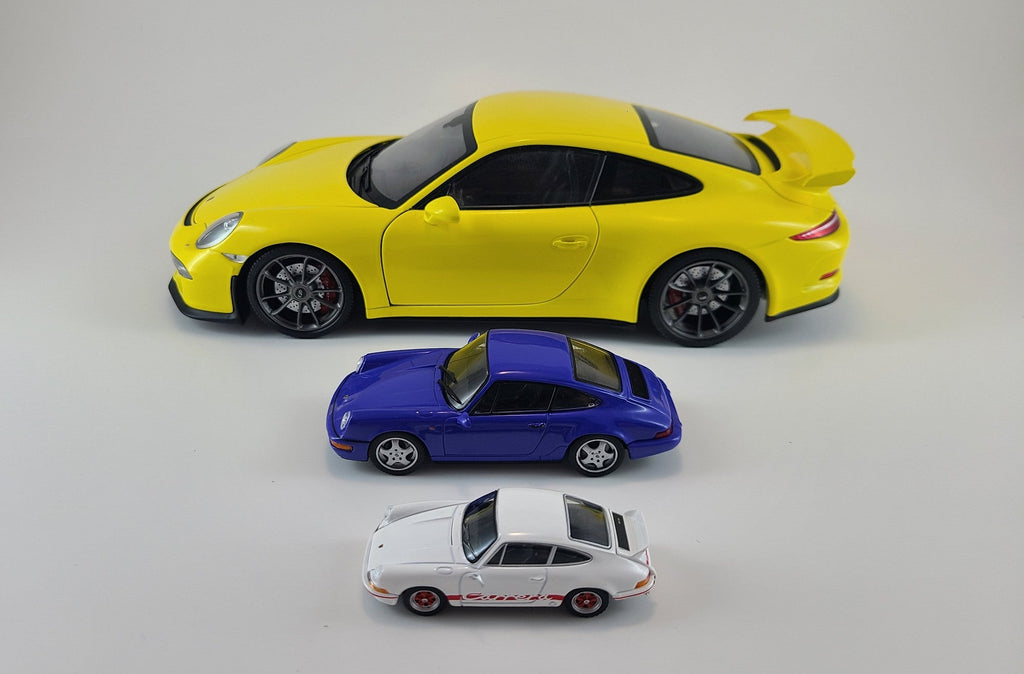
If you’re starting a model car collection from scratch, it’s critical to consider the space you have for your display, and that likely means choosing a scale of model that will best fit your spatial constraints. But what is scale? Newcomers to the diecast collecting hobby might be baffled by those oft-repeated numbers we veteran collectors always spout in reference to the size of the model car in question. Well, friends, scale is simply the ratio between the size of a miniature model car and that of its full-sized counterpart. When we talk about a 1:18-scale car, we mean that one unit of measurement on a model is equal to 18 units on the full-sized subject (in other words, 1 inch of model car for every 18 inches of real car). For example, a Porsche 992 Carrera is 177.9 inches long, so for a 1:18-scale model of this car to be accurately scaled, it would need to be about 9.9 inches long.
Model cars come in dozens of different scales, but over the years, Model Citizen has identified three preferred sizes based on general accuracy, high levels of detail, and quality and quantity of subject matter. To help you understand these scales a little better, here are the three scales in which Model Citizen specializes, from largest to smallest:

1:18. These are our “big guys,” typically measuring about nine to ten inches in length. 1:18 scale cars offer a tremendous amount of eye appeal, with a physical presence you’ll notice from across a room. First developed in Europe in the late 1970s, these large-format collectible models soon captured the imagination of American collectors thanks to their high level of detail and (in many cases) opening parts. Though smaller-scale model cars have taken an increasing share of the American market in recent years, we still love 1:18-scale cars as statement pieces that can become the focal point of a collector’s workspace or home recreation area.

1:43. With models measuring about four inches in length, 1:43 has been the “international collector’s scale” since the 1950s, and is arguably the most historic of all sizes of model car. Literally thousands of castings have been offered over the decades by countless model makers, meaning that the “back catalog” of subjects remains almost bottomless. 1:43-scale cars generally are made from diecast metal or resin, and give collectors a massive amount of detail in a compact, easy-to-display package. For their blend of detail, variety and compact size, we believe that 1:43-scale model cars offer the best overall value to model car enthusiasts.

1:64. Remember the Hot Wheels and Matchbox cars of your youth? These iconic three-inch toys were modelled roughly in 1:64 scale (though the cars’ actual sizes were dictated more by packaging requirements than by faithfulness to scale). In recent years, 1:64 has emerged as the hottest segment of the diecast hobby, with dozens of manufacturers entering the market with highly detailed, true-to-scale cars spanning an ever-expanding catalog of subject matter. At their best, these pocket-sized gems offer a surprising level of detail at an affordable price, making them an attractive entry point into the model car hobby.
Beyond these three scales on which we focus at Model Citizen, there are a number of other sizes of model car that are worthy of collectors’ consideration, including but not limited to:
1:12. Measuring around fifteen inches in length, 1:12-scale model cars are big, impressive items that can make a huge visual impact in an enthusiast’s display space. Typically priced between $150 and $1000, the variety of subject matter at this scale is somewhat limited, but a really great 1:12-scale car can serve as the anchor of a well-curated model collection, or as a compelling “man-cave” mantlepiece.
1:24. With a size rooted in architectural modelling, 1:24-scale should be familiar to children of the 1950s and ‘60s as the standard size for plastic model car kits. It would later become the main scale for the popular lines of classic American cars by the Franklin Mint and Danbury Mint. Though somewhat out of fashion now, 1:24-scale cars still have their fans, and out-of-production “Mint” cars can command big bucks on the secondary market.
1:36. Mostly obscure today, 1:36 was the chosen scale of Corgi models in the 1970s and 80s, which made them a gateway into model collecting for many a Gen X enthusiast.
1:87. These tiny cars are better known to model train enthusiasts as HO scale, and are highly coveted for their use in train layouts. There is a fascinating variety of subjects available at 1:87 scale, particularly for fans of German cars as companies like Minichamps, Herpa and Schuco have found success in producing home-market automobiles for their country’s legion of train hobbyists.
Of course, there are numerous other scales in the model car industry, with products to suit nearly any taste (or display space constraints). If you’re just starting your journey in the model car world, it might be worth considering your own spatial realities as well as the availability of your preferred marques in a particular scale…and as always, Model Citizen Diecast is standing by with advice!
